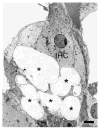Cochlear synaptopathy in acquired sensorineural hearing loss: Manifestations and mechanisms
- PMID: 28087419
- PMCID: PMC5438769
- DOI: 10.1016/j.heares.2017.01.003
Cochlear synaptopathy in acquired sensorineural hearing loss: Manifestations and mechanisms
Abstract
Common causes of hearing loss in humans - exposure to loud noise or ototoxic drugs and aging - often damage sensory hair cells, reflected as elevated thresholds on the clinical audiogram. Recent studies in animal models suggest, however, that well before this overt hearing loss can be seen, a more insidious, but likely more common, process is taking place that permanently interrupts synaptic communication between sensory inner hair cells and subsets of cochlear nerve fibers. The silencing of affected neurons alters auditory information processing, whether accompanied by threshold elevations or not, and is a likely contributor to a variety of perceptual abnormalities, including speech-in-noise difficulties, tinnitus and hyperacusis. Work described here will review structural and functional manifestations of this cochlear synaptopathy and will consider possible mechanisms underlying its appearance and progression in ears with and without traditional 'hearing loss' arising from several common causes in humans.
Keywords: Auditory nerve; Cochlear neuropathy; Cochlear synaptopathy; Hidden hearing loss; Noise-induced hearing loss.
Copyright © 2017 Elsevier B.V. All rights reserved.
Figures






References
-
- ACOEM Task Force on Occupational Hearing Loss. Kirchner DB, Evenson E, Dobie RA, Rabinowitz P, Crawford J, Kopke R, Hudson TW. Occupational noise-induced hearing loss: ACOEM Task Force on Occupational Hearing Loss. J Occup Environ Med. 2012;54:106–108. - PubMed
-
- American Academy of Audiology Position Statement and Clinical Practice Guidelines. Ototoxicity Monitoring. 2009 Oct; Available at: http://www.audiology.org/publications-resources/document-library/ototoxi....
-
- American Speech-Language-Hearing Association. Audiologic Management of Individuals Receiving Cochleotoxic Drug Therapy [Guidelines] 1994 Available at: www.asha.org/policy.
-
- Antoli-Candela F, Jr, Kiang NYS. Unit activity underlying the N1 potential. In: Naunton RF, Fernandez C, editors. Evoked Electrical Activity in the Auditory Nervous System. Academic Press; New York: 1978. pp. 165–191.
-
- Bae WY, Kim LS, Hur DY, Jeong SW, Kim JR. Secondary apoptosis of spiral ganglion cells induced by aminoglycoside: Fas-Fas ligand signaling pathway. Laryngoscope. 2008;118(9):1659–1668. - PubMed
Publication types
MeSH terms
Substances
Grants and funding
LinkOut - more resources
Full Text Sources
Other Literature Sources
Medical

